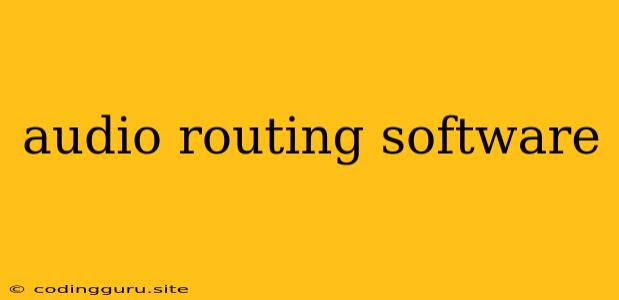Navigating the World of Audio Routing Software: A Comprehensive Guide
Audio routing software has become an indispensable tool for audio engineers, musicians, and anyone involved in audio production. It streamlines the process of managing audio signals, offering greater flexibility and control over your workflow. But with numerous options available, choosing the right audio routing software can feel overwhelming. This comprehensive guide will explore the key considerations, features, and benefits of using audio routing software.
What is Audio Routing Software?
Audio routing software acts as a central hub for your audio signals, allowing you to direct, mix, and manipulate audio streams from various sources. Imagine it as a digital patch bay, where you can connect microphones, instruments, software plugins, and other audio devices in a virtual environment.
Why Use Audio Routing Software?
The advantages of using audio routing software are numerous:
- Increased Flexibility: Audio routing software allows you to experiment with different routing configurations without the hassle of physically patching cables. This is particularly beneficial for live performances, where you can quickly switch between different setups.
- Streamlined Workflow: Say goodbye to the complexities of traditional patch bays. Audio routing software provides a clean and intuitive interface for managing your audio signals.
- Advanced Features: Many software options offer advanced features like signal processing, routing automation, and custom routing matrices, allowing for a more refined and creative approach to audio production.
- Enhanced Control: You gain granular control over your audio signals, with the ability to adjust levels, add effects, and manage routing in real time.
Key Features to Look for in Audio Routing Software
1. Routing Flexibility:
- Multi-channel Support: The software should accommodate a wide range of input and output channels, enabling you to connect various devices and instruments.
- Customizable Routing Matrices: Look for a software that offers flexible routing matrices, allowing you to create custom routing paths for specific projects or workflows.
2. Signal Processing:
- Built-in Effects: Many audio routing software include essential effects like EQ, compression, and reverb, adding another layer of creative control.
- Plugin Integration: The ability to integrate external plugins expands your signal processing options significantly.
3. Automation & Control:
- Automated Routing: The software should allow you to automate routing tasks, such as switching between different microphone setups or triggering specific effects.
- MIDI Control: The capability to control routing parameters via MIDI enhances your ability to integrate the software into live performances.
4. User Interface:
- Intuitive Design: Choose a software with a clear and user-friendly interface that facilitates smooth navigation and routing.
- Visualization Tools: Visual representations of audio signals and routing paths enhance understanding and workflow efficiency.
Tips for Choosing the Right Audio Routing Software
- Define your Needs: Before you begin your search, consider the specific tasks you want to accomplish with the software. This will help narrow down your choices.
- Evaluate Compatibility: Ensure the software you choose is compatible with your operating system, audio interface, and other audio devices.
- Explore Features: Test drive the software and explore its features to see if they meet your workflow requirements and creative vision.
- Read Reviews: Look at user reviews and testimonials to gain insights from others who have used the software.
- Consider Your Budget: Audio routing software comes in various price ranges. Set a realistic budget and explore options that fit your financial constraints.
Popular Audio Routing Software Options
The market is filled with a diverse range of audio routing software, each catering to different needs and preferences. Some popular options include:
- Ableton Live: While primarily a DAW, Live excels in its live performance capabilities and flexible routing features.
- Max/MSP: A powerful platform for creating custom audio routing solutions and visual feedback.
- Logic Pro X: Offers comprehensive routing capabilities, including flexible routing matrices and custom signal paths.
- Pro Tools: A renowned industry standard, Pro Tools offers robust routing features and a wide range of plugins.
- Reaper: A versatile and affordable option with powerful routing capabilities and a user-friendly interface.
Conclusion
Choosing the right audio routing software is crucial for maximizing your audio workflow efficiency and creativity. By carefully considering your needs, exploring features, and testing various options, you can find the perfect solution for your specific requirements. Embrace the flexibility and control offered by audio routing software and unlock your full potential as an audio engineer or musician.
